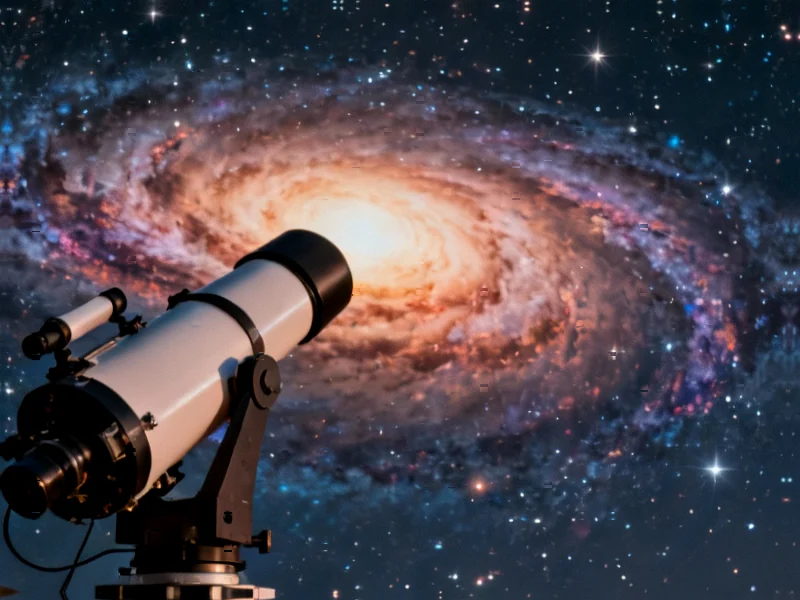According to SciTechDaily, astronomers have successfully applied a novel photonic lantern imaging technique to a ground-based telescope for the first time, capturing the most precise view ever recorded of a star’s surrounding disk. The UCLA-led team used the Subaru Telescope in Hawai’i equipped with the FIRST-PL system to observe beta Canis Minoris, located 162 light-years from Earth, achieving measurements with about five times greater precision than previously possible. The photonic lantern device, developed through collaboration between the University of Sydney and University of Central Florida, splits starlight into components based on wavefront patterns and color, preserving subtle details normally lost. The team’s unexpected discovery of a lopsided disc around β CMi, detailed in the October 22, 2025 Astrophysical Journal Letters publication, demonstrates how this technology can reveal previously invisible structural features. This breakthrough represents a fundamental shift in how we approach astronomical imaging.
Table of Contents
The Photonic Revolution in Astronomy
What makes this development particularly significant is how it fundamentally challenges traditional approaches to astronomy resolution enhancement. For decades, the primary path to sharper images involved building larger telescopes or creating interferometric arrays that combine signals from multiple instruments. The photonic lantern approach represents a paradigm shift – instead of scaling up physical infrastructure, researchers are now scaling up information extraction from existing light collection. This mirrors similar revolutions in other fields where computational advances have enabled better data extraction from existing hardware, much like how modern image processing can extract details from digital photos that weren’t visible to the naked eye.
Overcoming Fundamental Physics Limits
The real breakthrough here isn’t just the improved resolution, but how the team overcame the diffraction limit – a fundamental barrier in optics that dictates the finest detail observable for any given telescope aperture size. Traditional imaging systems hit this wall because they essentially average light information. The photonic lantern’s ability to separate light based on wavefront patterns before detection means it’s capturing phase information that conventional systems discard. This is similar to moving from a simple light meter to a full wavefront sensor. The atmospheric turbulence correction mentioned in the research represents another layer of innovation – even with advanced adaptive optics, the system required new computational techniques to filter out remaining atmospheric effects, suggesting this technology pushes sensitivity to the absolute limits of what’s measurable from Earth’s surface.
Practical Implications for Astronomical Research
This technology could democratize high-resolution astronomy. Building massive telescope arrays like the Subaru Telescope or the upcoming Extremely Large Telescope requires billions in funding and decades of development. If photonic lantern technology can be adapted to smaller, more accessible telescopes, it could put high-resolution capabilities within reach of more research institutions. The immediate application for studying circumstellar disks around stars like β CMi is just the beginning. This approach could revolutionize exoplanet characterization, allowing researchers to study atmospheric features of distant worlds with unprecedented detail. The discovery of asymmetry in the disk around β CMi itself raises fascinating questions about planetary formation processes and stellar system evolution that will require new theoretical models to explain.
The Road Ahead for Photonic Astronomy
While the results are impressive, several challenges remain before this technology becomes mainstream. The sensitivity to atmospheric turbulence suggests that these systems may require even more sophisticated adaptive optics than current state-of-the-art systems. The computational demands for processing the separated light channels are substantial, and scaling this approach to fainter objects will require significant optimization. There’s also the question of how well this technique translates to different wavelength regimes – the current success with visible/near-infrared light doesn’t guarantee similar performance at radio or X-ray wavelengths. However, the fundamental principle of exploiting photonics to extract more information from collected light could inspire similar innovations across the electromagnetic spectrum.
Broader Scientific Impact
Beyond astronomy, this development demonstrates the power of interdisciplinary collaboration. The fusion of astronomical instrumentation with advanced photonics technology created something neither field could achieve alone. This pattern of cross-pollination between traditionally separate disciplines is becoming increasingly common in cutting-edge research. The techniques developed here could find applications in medical imaging, remote sensing, or even quantum information processing. As the research team noted in their published paper, they’re “just getting started” – which suggests we should expect even more dramatic improvements as the technology matures and researchers gain experience with this new way of seeing the universe.
Related Articles You May Find Interesting
- Oracle’s $300B OpenAI Deal Sparks Valuation Reality Check
- Meta’s $40B AI Gamble: Bold Vision or Reckless Spending?
- The Teen Economy: How Gen Z Is Reshaping Finance
- Nintendo’s $17,500 Legal Victory Over Defiant Streamer Signals New Anti-Piracy Era
- The x402 Protocol: How AI Agents Are Building Their Own Economy



